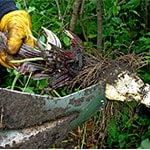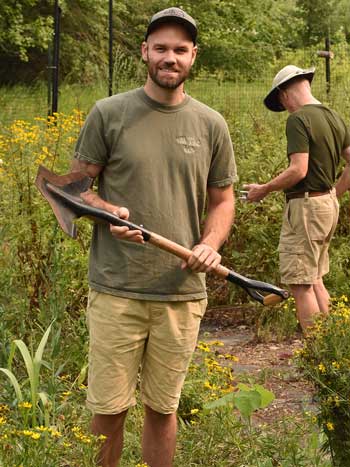Controlling Biennial
Invasives Without Herbicide
Using A Parsnip Predator
By Jim Rogala

My recent blog post on girdling got me thinking about other herbicide-free invasive species control methods. For biennials, there are three common mechanical control methods: mowing, pulling, and cutting below the root crown. Mowing is favored for large infestations because of the daunting task of methods used on individual plants. Pulling or root severing is feasible on small infestations. For some biennials, such as sweet clover, pulling works if conditions are right. However, there are some species where pulling is not that effective, and in those cases, root severing is a better method. In this post, I’ll discuss using root severing as a method to control biennials.
How it Works
As with girdling, the control of biennials also takes advantage of the plant’s anatomy and physiology to kill plants without using herbicides. In this case, we take advantage of the inability of many biennials to re-sprout if cut at some depth below ground level. These plants typically have taproots with all the adventitious buds (the source of re-sprouting) near the soil surface, thus allowing all the buds to be removed with below-ground cutting. Technically, many of these can live more than two years (they live until they flower), but without resprouts they are dead. Typically, cutting 2” or more below the root crown will suffice, but in some cases, I’ve found it successful at even less than 2”. There are many factors that affect resprouting, such as growth stage, nutrient storage, and other simultaneous stressors (e.g., shading), so keep these in mind as you decide how deep you need to go.
How to Cut the Crown
So, how does someone efficiently cut a root under the ground? The Parsnip Predator is a modified shovel that was designed specifically for this purpose by The Prairie Enthusiasts Prairie Bluff Chapter. Though obviously designed for wild parsnip, I’ve used it on other biennials such as sweet clover, burdock, and biennial thistles. I also find it handy to use on some annuals to minimize seed production, and for some perennials to set them back. I even use it for above ground severing of young tree sprouts when I’m double-cutting species such as aspen and sumac. I actually seldom use it as one would typically use a shovel, but rather just thrust the blade into the ground at an angle through the root of biennials or through the stems of perennials (and tree resprouts).
There are some advantages of root severing as opposed to other mechanical methods. As opposed to mowing, the severing allows the surrounding vegetation to stay intact, therefore not only leaving desirable species unharmed but providing shading of the potential resprouting biennial. Even though the repeated thrusting of the shovel is hard on the body, I find it less abusive than the constant bending over to pull biennials. And when it comes to parsnip, I like the idea of not having to grab a plant that has harmful juices in it! It can also be done under most soil moisture conditions, whereas pulling works best in moist soils.
The next time you need to address problems with biennials, consider using root severing to your potential management approaches and add a Parsnip Predator (or two!) to your toolshed.

